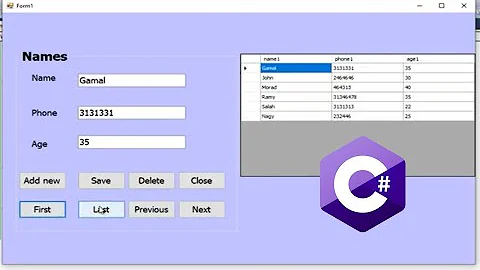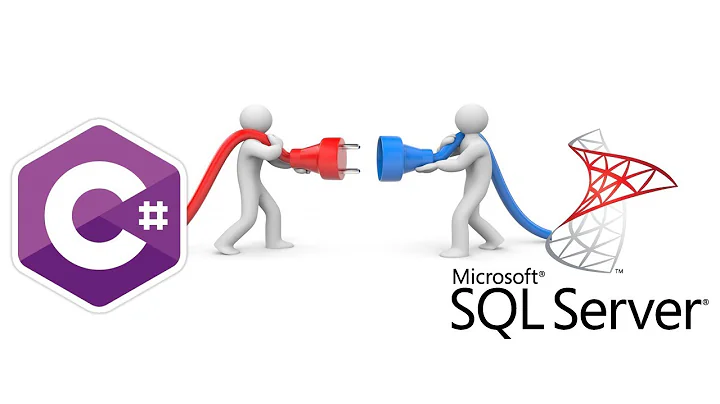How do I connect to a SQL database from C#?
Solution 1
Check out
I'm sure there's plenty more out there - just google for "ADO.NET" and "Tutorial" ......
UPDATE:
If you want to connect to your local SQL Server Express, and connect to the "Northwind" database, and read the top 5 customers from the "Customers" table, you'd have to do something like this:
string connectionString = "server=(local)\SQLExpress;database=Northwind;integrated Security=SSPI;";
using(SqlConnection _con = new SqlConnection(connectionString))
{
string queryStatement = "SELECT TOP 5 * FROM dbo.Customers ORDER BY CustomerID";
using(SqlCommand _cmd = new SqlCommand(queryStatement, _con))
{
DataTable customerTable = new DataTable("Top5Customers");
SqlDataAdapter _dap = new SqlDataAdapter(_cmd);
_con.Open();
_dap.Fill(customerTable);
_con.Close();
}
}
Now you would have all 5 top customers from your Northwind database in the DataTable and you can inspect them, print them out, manipulate them - whatever you want to do.
That's ADO.NET in action!
As for the details of the connection string - what options you can use and what it should look like, check out the Connection Strings web site - it has tons of examples and explanations.
Marc
Solution 2
object is made for this.
Eg:
SqlConnection conn = new SqlConnection(
"Data Source=(local);Initial Catalog=Northwind;Integrated Security=SSPI");
or
SqlConnection conn = new SqlConnection(
"Data Source=DatabaseServer; Initial Catalog=Northwind; User ID=YourUserID; Password=YourPassword");
conn.Open(); // opens the database connection
Edit:
After doing all your stuff you have to close the connection by
conn.Close();
Data Source: Identifies the server. Could be local machine, machine domain name, or IP Address.
Initial Catalog: Database name.
Integrated Security: Set to SSPI to make connection with user's Windows login
User ID: Name of user configured in SQL Server.
Password: Password matching SQL Server User ID.
Solution 3
To connect to SQL Server Express you need nothing but System.Data, which is a standard .NET assembly. Just use SqlXXX classes and you'll be done.
However, writing mundane ADO.NET code is very boring, so it's very common to use an ORM or less heavy-weight result-set mapper such as BLToolkit.
And finally, consider using SQL Server CE. This is a fully ACID-compliant single-file embedded database engine which supports pretty much any feature you can expect form an SQL RDBMS.
Solution 4
Currently the easiest way to connect to your database and perform queries in C# is LinqToSQL. It will save you a lot of headache as compared to using "old-school" ADO connections.
Solution 5
I wish this will help just try these..
@CLASS
using System.Data;
using System.Data.SqlClient;
namespace WindowsFormsApplication2
{
class clsDB
{
public SqlDataAdapter mDataAdapter = new SqlDataAdapter();
public DataSet mDataSet = new DataSet();
public SqlConnection mConn;
public clsDB()
{
mConn = new SqlConnection("Data Source=(the data source);Initial Catalog=sample;User ID=(the id);Password=(the password)");
}
public void SQLDB(string strSQL)
{
try
{
mDataAdapter = new SqlDataAdapter(new SqlCommand(strSQL, mConn));
mDataSet = new DataSet();
mDataAdapter.Fill(mDataSet);
}
catch (Exception ex)
{
throw ex;
}
finally
{
mConn.Close();
}
}
public void ClearRes()
{
mDataAdapter.Dispose();
mDataAdapter = null;
mDataSet.Dispose();
if (mConn.State != ConnectionState.Closed)
{
mConn.Close();
}
}
}
}
@LOGIN
public partial class Login : Form
{
clsDB x = new clsDB();
public Login()
{
InitializeComponent();
}
private void btnSubmit_Click(object sender, EventArgs e)
{
x.SQLDB("select * from tbl_accounts where u_username ='" + txtUser.Text + "' and u_password ='" + txtPass.Text + "'");
if (x.mDataSet.Tables[0].Rows.Count > 0)
{
Main a = new Main();
this.Hide();
a.Show();
}
else
{
MessageBox.Show("wrong username or password");
}
}
@MAIN ACCESS
namespace WindowsFormsApplication2
{
public partial class Main : Form
{
clsDB x = new clsDB();
public Main()
{
InitializeComponent();
}
private void btnAdd_Click(object sender, EventArgs e)
{
x.SQLDB("insert into tbl_info (u_lastname, u_firstname, u_middlename) values ('" + atxtLN.Text + "','" + atxtFN.Text + "','" + atxtFN.Text + "')");
fillgrid();
}
private void Main_Load(object sender, EventArgs e)
{
x.SQLDB(" select * from tbl_info ");
dgv1.DataSource = x.mDataSet.Tables[0];
fillgrid();
}
void fillgrid()
{
x.SQLDB("select * from tbl_info");
dgv1.DataSource = null;
dgv1.DataSource = x.mDataSet.Tables[0];
}
void search()
{
x.SQLDB("SELECT * from tbl_info where u_id like '" + etxtID.Text + "%' order by u_id");
if (x.mDataSet.Tables[0].Rows.Count > 0)
{
x.mDataAdapter.Fill(x.mDataSet, "tbl_info");
dgv1.DataSource = x.mDataSet.Tables["tbl_info"].DefaultView;
etxtLN.Text = dgv1.Rows[dgv1.CurrentRow.Index].Cells["u_lastname"].Value.ToString();
etxtFN.Text = dgv1.Rows[dgv1.CurrentRow.Index].Cells["u_firstname"].Value.ToString();
etxtMN.Text = dgv1.Rows[dgv1.CurrentRow.Index].Cells["u_middlename"].Value.ToString();
}
else if (etxtID.Text == "Type User ID to Edit")
{
etxtLN.Text = "";
etxtFN.Text = "";
etxtMN.Text = "";
}
else
{
etxtLN.Text = "";
etxtFN.Text = "";
etxtMN.Text = "";
}
}
private void etxtID_TextChanged(object sender, EventArgs e)
{
}
private void etxtID_Enter(object sender, EventArgs e)
{
etxtID.Text = "";
etxtID.ForeColor = Color.Black;
}
private void etxtID_Leave(object sender, EventArgs e)
{
if (etxtID.Text == "")
{
etxtID.ForeColor = Color.Gray;
etxtID.Text = "Type User ID to Edit";
x.SQLDB(" select * from tbl_info ");
dgv1.DataSource = x.mDataSet.Tables[0];
fillgrid();
}
}
private void etxtID_KeyUp(object sender, KeyEventArgs e)
{
search();
}
private void btnUpdate_Click(object sender, EventArgs e)
{
x.SQLDB("UPDATE tbl_info set u_lastname ='" + etxtLN.Text + "', u_firstname ='" + etxtFN.Text + "', u_middlename ='" + etxtMN.Text + "' where u_id =" + etxtID.Text);
MessageBox.Show("Operation Successful!");
fillgrid();
}
private void btnDelete_Click(object sender, EventArgs e)
{
x.SQLDB("delete from tbl_info where u_id =" + dtxtID.Text + "");
MessageBox.Show("Operation Successful!");
fillgrid();
}
}
}
Related videos on Youtube
Comments
-
RCIX almost 2 years
I am trying to write a local program management and install system for my home network, and I think I've got the technologies nailed down:
- C#/.NET/WPF for the client
- Lua for installation scripting support (through LuaInterface)
- SQL Server Express for maintaining a database of programs
However I'm unsure what specifically I'll use to connect C# to the database. Is there something built into the .NET framework for this? Bonus points if you have a suggestion on what I should use for interacting with said database.
-
RCIX over 14 yearsUm, this may sound like a dumb question but how doesw ADO.NET relate to my question?
-
marc_s over 14 yearsADO.NET is the .NET subsystem to connect from C# or VB.NET to a database like SQL Server, SQL SErver Express, Oracle or whatever
-
RCIX over 14 yearsThat deals with using an object as a database, i've set up an instance of SQL server express for that.
-
marc_s over 14 yearsEF seems a bit overkill just for a very small beginner's sample...... unnecessarily complicates things, in my opinion. Learn the basics of bare bones ADO.NET first!
-
 Christian Hayter over 14 years+1 from a fellow "downvote with no comment" recipient. There is nothing incorrect or unhelpful in this answer.
Christian Hayter over 14 years+1 from a fellow "downvote with no comment" recipient. There is nothing incorrect or unhelpful in this answer. -
RCIX over 14 years[Disclaimer: i didn't downvote it] How do i use an Entity Framework or Linq to SQL with this?
-
RCIX over 14 yearsOk, how do i use LINQ to SQL or similar with this?
-
marc_s over 14 yearsLINQ-to-SQL builds on top of ADO.NET - you don't "waste" anything if you first learn the basics of ADO.NET, and once you understand that, move on to LINQ-to-SQL or Entity Framework.
-
 Lieven Keersmaekers over 14 yearslol. A bit of a stretch but now someone should come in and downvote for just opening and closing the connection without actually doing something with it. The real reason offcourse should only be divulged after enough people wonder why oh why...
Lieven Keersmaekers over 14 yearslol. A bit of a stretch but now someone should come in and downvote for just opening and closing the connection without actually doing something with it. The real reason offcourse should only be divulged after enough people wonder why oh why... -
MRG over 14 yearsI agree with marc_s.its always good to learn basics first and I dont think it will take much time also ( for ADO.Net )







